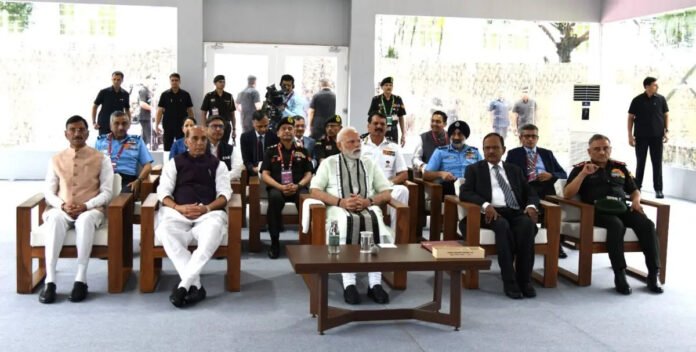The Joint Military Space Doctrine, which was recently released in the Kolkata Combined Commanders Conference 2025, is a significant and strategic milestone in the formal institutionalisation of space as a critical operational domain within India’s national security and defence architecture. This doctrine has been disclosed in the context of escalating global competition in space, particularly in light of China’s accelerated development of military space capabilities and the escalating tensions in the region. It establishes space as a unique and essential domain of military operations and outlines the roadmap for the integration of space assets and functions throughout the Indian Armed Forces.
Space as a Critical Operational Domain
Space has gained recognition as an independent operational domain on par with land, sea, and air, despite being traditionally regarded as an extension of air and missile defence. Specialised strategies and capabilities are required due to the doctrine’s emphasis on distinctive spatial characteristics, including orbital dynamics, electromagnetic spectrum access, and external environmental challenges. Space is now recognised as the enabler of critical functions, such as surveillance, reconnaissance, satellite communications, navigation, and missile monitoring. These capabilities are essential for command, control, and situational awareness in contemporary warfare, in addition to serving as force multipliers.
The formalisation of space as an operational domain is indicative of a strategic transition in India’s approach to defence in a multi-domain battlespace, which prioritises freedom of action and dominance in space as critical components of national security
The formalisation of space as an operational domain is indicative of a strategic transition in India’s approach to defence in a multi-domain battlespace, which prioritises freedom of action and dominance in space as critical components of national security.
Addressing the Emergence of Space Threats
The doctrine’s publication emphasises India’s acknowledgment of the changing nature of space threats, particularly those posed by regional adversaries such as China and Pakistan. New vulnerabilities have been introduced by the rapid development of anti-satellite (ASAT) weapons, satellite interference, and cyber and electronic warfare that target space assets. A strong response is required in light of China’s ongoing efforts to militarise the space environment and its demonstrated ASAT capabilities. The doctrine therefore emphasises the development of rapid response mechanisms to neutralise adversary actions, the protection of Indian space infrastructure, and the enhancement of space situational awareness to detect potential threats.
This methodology acknowledges that the operational efficacy of all domains would be substantially impaired by the disruption or degradation of space-based capabilities.
The doctrine recognises that technology will influence future conflicts and underscores the importance of utilising advancements such as artificial intelligence and machine learning to improve space operations. It promotes the rapid development and deployment of indigenous space systems to reduce external dependencies, in accordance with India’s Aatmanirbharta (self-reliance) vision
Promoting the Integration of Tri-Services
One of the doctrine’s primary objectives is to promote synergy and jointness among the Indian Army, Navy, and Air Force in space operations. It is consistent with the broader initiatives to establish joint military stations and establish unified structures, such as the Tri-Service Education Corps, to facilitate interoperability. Space capabilities will provide direct support for land, sea, and air operations in an integrated manner, particularly through secure communications and intelligence, surveillance, and reconnaissance (ISR).
“India’s space doctrines have been primarily fragmented among the Army, Navy, and Air Force until recently, with each service establishing its perspective and capabilities for space operations. The absence of a unified approach resulted in the formation of operational divisions, which impair the integration and coordination of space functions that are essential for the joint military’s effectiveness. The new Joint Military Space Doctrine addresses this issue by integrating all three services for integrated space operations within a cohesive framework, thereby improving India’s overall defence posture in the space domain.”
This integration enables the efficient utilisation of data and resources from space, thereby increasing their effectiveness in a variety of mission scenarios.
Adopting a Future Driven by Technology
The doctrine recognises that technology will influence future conflicts and underscores the importance of utilising advancements such as artificial intelligence and machine learning to improve space operations. It promotes the rapid development and deployment of indigenous space systems to reduce external dependencies, in accordance with India’s Aatmanirbharta (self-reliance) vision. The doctrine also emphasises the critical importance of incorporating sophisticated electronic warfare capabilities and enhancing cyber resilience.
India will be able to effectively counter emerging threats and maintain operational agility in a swiftly evolving space environment by establishing strategic technological self-reliance.
Global and Strategic Consequences
India’s defence posture is in alignment with that of global powers such as the United States, Russia, and China by institutionalising space as a military domain. These nations regard space as a contested frontier that is essential to national security. The doctrine acknowledges the strategic significance of space dominance for the stability of the broader geopolitical landscape and regional security.
India’s dedication to responsible space behaviour and its contributions to global space security and sustainable use are emphasised in addition to its assertion of sovereignty over its space assets and capabilities.
The Joint Military Space Doctrine is a significant development in India’s defence strategy, as it acknowledges space as a sovereign and critical operational domain. The doctrine establishes a clear strategic orientation for the effective protection and utilisation of space capabilities by addressing emerging threats, promoting tri-service integration, and emphasising indigenous technological innovation
Capacity Development and Implementation
The doctrine establishes a structured roadmap for the development of capacity by implementing reforms in operational concepts, training, and force structure. The Tri-Service Education Corps and the ongoing establishment of joint military stations will institutionalise joint space operations and improve personnel readiness. The objective of these initiatives is to guarantee that space elements are thoroughly integrated into coordinated multi-domain operations, rapid decision-making, and consistent doctrine-based planning.
The necessary knowledge and skills for space-centric warfare will be provided to future military leaders and operators through reforms in training and education.
In conclusion, the Joint Military Space Doctrine is a significant development in India’s defence strategy, as it acknowledges space as a sovereign and critical operational domain. The doctrine establishes a clear strategic orientation for the effective protection and utilisation of space capabilities by addressing emerging threats, promoting tri-service integration, and emphasising indigenous technological innovation. It equips India’s armed forces to operate seamlessly across multiple domains, including the increasingly contested space frontier, thereby ensuring national security and contributing to global stability in the decades ahead. This doctrine is a critical step in the development of a military posture that is future-ready and integrated and that completely leverages the strategic potential of space.
The writer is the Publisher of Frontier India and the author of the book Foxtrot to Arihant: The Story of Indian Navy’s Submarine Arm.






